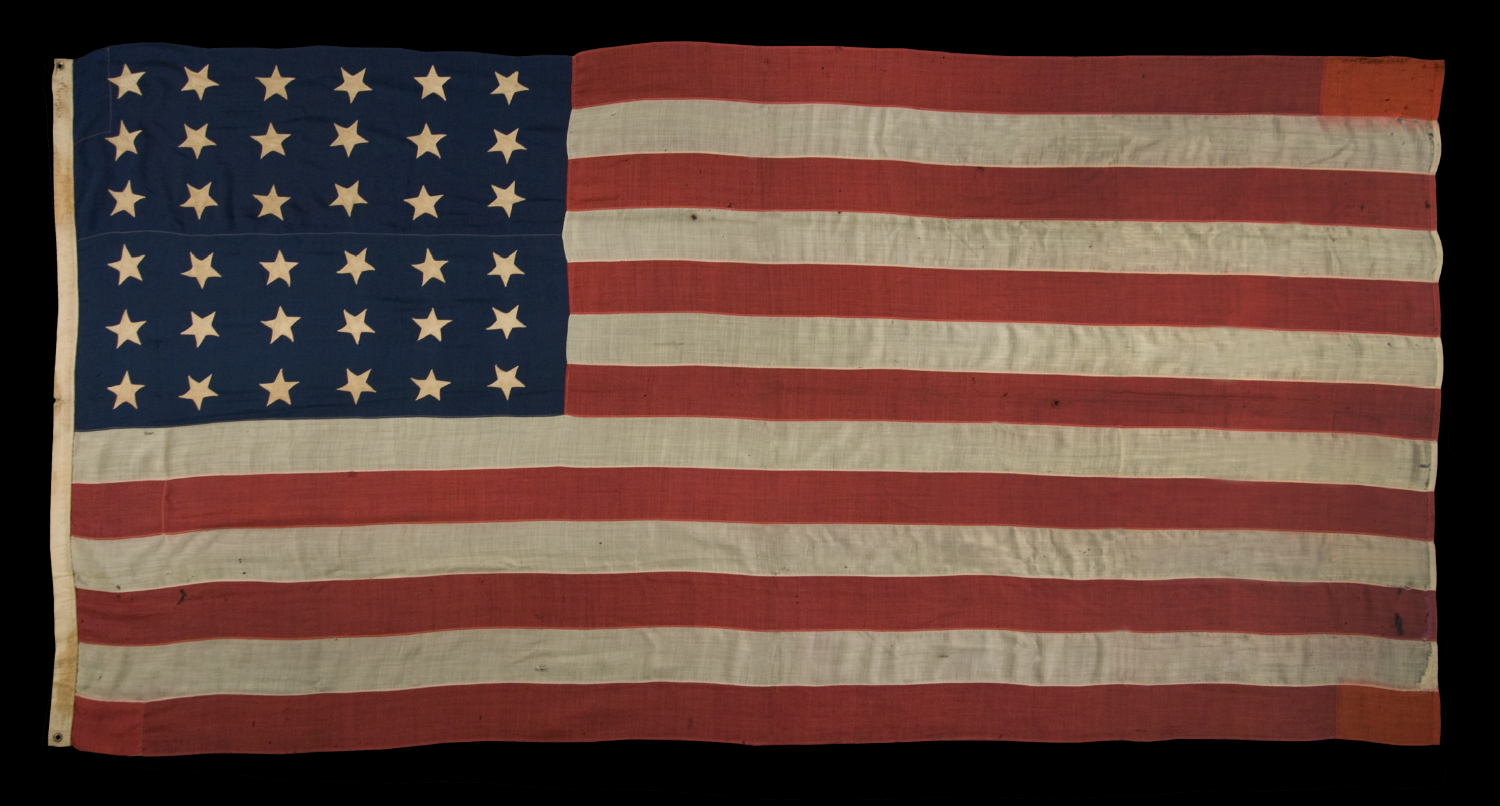
| |
36 SINGLE-APPLIQUÉD STARS ON AN CIVIL WAR ERA FLAG WITH ELONGATED PROPORTIONS, SIGNED "CHRISTY," 1864-1867, NEVADA STATEHOOD |
|
| Available: |
Sold |
| Frame Size (H x L): |
n/a |
| Flag Size (H x L): |
72" x 130" |
|
| Description....: |
|
36 SINGLE-APPLIQUÉD STARS ON AN CIVIL WAR ERA FLAG WITH ELONGATED PROPORTIONS, SIGNED "CHRISTY," 1864-1867, NEVADA STATEHOOD:
36 star American national flag of the Civil War era, in a large scale typical of the 19th century. Lincoln pushed Nevada through to statehood on October 31st, 1864, during the Civil War and just 8 days before the November election. The territory’s wealth in silver was attractive to a nation struggling with the debts of war and the president's support of statehood increased support for the Republican ticket.
While the 36th star wouldn't officially be added until July 4th of the following year, flag-makers cared little for official counts. Some would have even begun adding the 36th star several months before the addition of Nevada actually occurred and almost all would have added it after Nevada was in. Commercially produced flags with inscribed dates are known as early as July of 1864, four months before Nevada's addition. Adding stars before they were official was common practice during the late 19th century and reflects both the nation's desire for Westward Expansion and the hope of flag-makers to bring new star counts to market before their competitors. The 36 star flag was officially replaced by the 37 star flag in 1867, following the addition of Nebraska.
The stars of the flag are made of cotton and single-appliquéd. This means that they were applied to one side of the canton, then the blue fabric was cut from behind each star, folded over, and under-hemmed, so that one star could be viewed on both sides. The stars were applied with a treadle machine and the fine and careful under-hemming was completed by hand with the extreme precision of a highly skilled seamstress. I always find single-appliquéd stars to be more interesting, not only because they are evidence of a more difficult level of seam-work and stitching, but even more so because they are often more visually pleasing. The extra row of stitching makes the sewn construction even more apparent and is an attractive feature. In addition, note how the stars point this way and that on their vertical axis, which adds a whimsical element to the overall design. This particularly nice characteristic is shared across many 19th century flags, setting them apart from their modern counterparts.
The stripes and canton of the flag are made of wool bunting that has been pieced and sewn with treadle stitching. Because blue wool bunting was only available in a maximum width of eighteen inches, the canton has been pieced from two lengths of fabric. The rectangular patches at the top and bottom of the hoist end are original to the flag's construction. These are called gussets and were added for support at the points where the flag received the most stress when it was flown. Usually these are similar in size and shape to one-another, but in this case the two are not at all alike, which makes them rather interesting. There is a wide canvas binding along the hoist with two brass grommets, one each at the extreme top and bottom. This was applied with two rows of chain treadle stitching.
The name "Christy" was inscribed along the hoist near the top on the obverse. This denotes the name of a former owner and it was common to mark flags in this fashion to indicate ownership during the 19th and early 20th centuries.
Most flags with pieced-and-sewn construction made prior to the 1890's measured 8 feet long and larger. At approximately 6 feet on the hoist by 11 feet on the fly, this may seem very large by modern standards, but it was common in the period of the flag's manufacture, when garrison flags were a whopping 35 to 45 feet in length.
Mounting: The flag has not yet been mounted. We are experts in the framing of antique flags. We employ professional staff with masters degrees in textile conservation and can attend to all of your mounting and framing needs.
Condition: There is some soiling in the white cotton and canvas and there are a number of small holes throughout. There are darning repairs at the fly end of the 11th and 12th stripes. There are patches at the fly end of the first and last stripe, applied to repair losses from wind shear. The wool bunting used to do this was not colorfast, which resulted in minor bleeding of the red into the white wool along these lengths of fabric. Many of my clients prefer early flags to show their age and history of use. |
|
|
|
| Collector Level: |
Intermediate-Level Collectors and Special Gifts |
|
| Flag Type: |
Sewn flag |
|
| Star Count: |
36 |
|
| Earliest Date of Origin: |
1864 |
|
| Latest Date of Origin: |
1867 |
|
| State/Affiliation: |
Nevada |
|
| War Association: |
1861-1865 Civil War |
|
| Price: |
SOLD |
|
| |
Views: 2566 |
|
|
|

